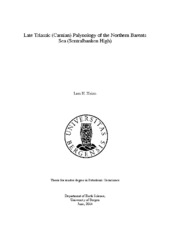Late Triassic (Carnian) Palynology of the Northern Barents Sea (Sentralbanken High)
Master thesis
Permanent lenke
https://hdl.handle.net/1956/8279Utgivelsesdato
2014-06-23Metadata
Vis full innførselSamlinger
- Department of Earth Science [1050]
Sammendrag
This study is part of a broader palynological investigation of late Middle to Late Triassic, where the main aim is to improve the biostratigraphic resolution by applying palynology. The low abundance of macrofossils (e.g. ammonites) in Svalbard and the Barents area, coupled with the long duration of the Late Triassic Epoch results in very low biostratigraphic resolution. This makes palynology an important tool for resolving the stratigraphy and dating the successions. In this study, 31 palynological samples were analysed from core 7533/3-U-7 drilled through the Snadd Formation on the Sentralbanken High, northern Barents Sea. Four assemblages were recognized, all of which were assigned a mid to late Carnian age. Palynofacies analysis was integrated with sedimentological facies, and the depostional environment was interpreted to represent a delta plain. Eight additional samples from Blåfjellet (Hopen), from the De Geerdalen Formation, were also incorporated into this study at a later stage. Two assemblages were recognized from these samples, where the lowermost assemblage was assigned a mid to late Carnian age and the uppermost a possible latest Carnian age. The logged section on Blåfjellet was also interpreted to represent a delta plain setting, with a possible shallow marine interval in the upper and lower parts of the logged section. This interpretation was based on the sedimentological log; no major changes were recorded in the palynofacies. Also, marine indicators, such as acritarchs, were absent in all the samples from Hopen. The palynofacies and the palynological assemblages recorded in the samples from Hopen closely resembled those from core 7533/3-U-7, i.e. palynofacies dominated by wood particles and palynological assemblage dominated by terrestrial taxa. Abundant fern spores, such as Leschikisporis, Concavisporites, Deltoidospora, Dyctyophyllidites and Duplexisporites were recorded in the samples from core 7533/3-U-7 and Hopen. This indicates humid warm conditions during the time of deposition (Abbink et al., 2004). The terrestrial taxa, palynofacies results and sedimentological facies recorded in this study reflects the paralic nature of the Upper Triassic (Carnian) Barents Shelf (Riis et al., 2008).
